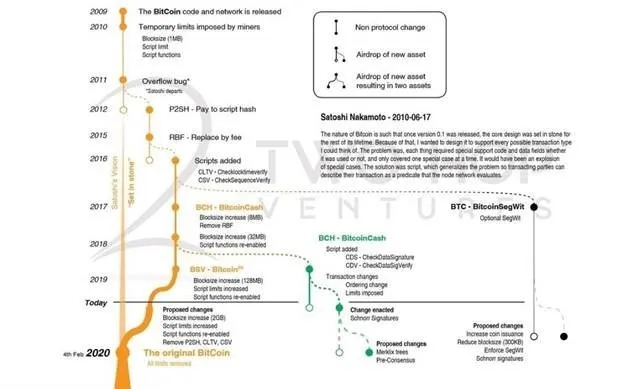|
Getting your Trinity Audio player ready...
|
On February 4, 1:35 am UTC, Bitcoin SV (BSV) officially returned to the original Bitcoin. Block height #620538, which was 1.84MB in size and contained 725 transactions, was the block that activated the Genesis protocol upgrade. The hard fork implemented a new set of rules into the BSV network, and then TAAL mining firm locked Genesis on the next block, #620539.
The Genesis upgraded has removed the block size limit from the BSV blockchain as well as all restrictions previously implemented by BTC and BCH.
Where BTC and BCH went wrong

Bitcoin SV is the only version of Bitcoin that stays true to the Bitcoin whitepaper. Let’s take a closer look at why this is the case so you can understand the true history of Bitcoin.
BTC went wrong when Core developers decided to technologically limit the block size to 1MB as well as implement scripts like pay-to-script-hash (P2SH), Check Lock Time Verify (CLTV), replace by fee (RBF), and Check Sequence Verify (CSV). In addition, Core developers moved scaling “off-chain,” something unnecessary and never discussed in the whitepaper.
When the BTC community was proposing Segwit, the implementation that would later enable the off-chain scaling that the core developers wanted, many people realized that this update was derailing BTC from what the whitepaper set Bitcoin out to be. In order to get Segwit activated, BTC core forked off bitcoin on August 1, 2017, this changed Bitcoin’s ticker symbol to BCH. Back in 2017, BCH was the closest thing to Bitcoin as described in the whitepaper. The BCH blockchain had 32MB blocks to solve the scaling crisis, and removed some of the scripts Bitcoin implemented like RBF.
Unfortunately, BCH had a few mishaps of its own. The BCH blockchain was not scaling at the rate it needed to for software developers to effectively build the businesses, programs, and services that they envisioned. In addition, BCH developers had plans to add scripts of their own. However, these scripts were moving the BCH protocol off the path the whitepaper had set out. Once again, individuals within the BCH community realized that the plans the BCH protocol developers had for the network were turning it into something that was not bitcoin. Therefore, on November 15, 2018, the BCH forked off the bitcoin protocol, creating Bitcoin SV, a blockchain that was looking to return Bitcoin to its original form as described in the whitepaper.
Bitcoin SV, the original Bitcoin
The Genesis protocol upgrade restored Bitcoin SV to as close as possible to the original Bitcoin, the same Bitcoin that Satoshi Nakamoto describes in the whitepaper. The upgrade removed all of the limitations initially added by BTC and BCH developers that prevented the cryptocurrency from being Bitcoin.
With these limitations removed, the possibilities regarding what can be built on Bitcoin as well as the problems Bitcoin can be used to solve are endless. In the early days of cryptocurrency, many software developers wanted to build their applications and businesses on top of Bitcoin. However, the block size and technical parameters were too limiting to make this possible.
As an alternative, they turned to Ethereum, a blockchain that allowed them to build the applications and businesses they desired, but still came with technical obstacles and limitations that cannot be overcome. This is why ETH is considered a hobby platform in the blockchain space. But now, with Bitcoin SV, software developers can build the businesses, platforms, and applications that they desire, without having to worry about circumnavigating an artificial scaling ceiling and technical restrictions put in place by the network; on BSV, there are no limitations.
What can I do with BSV?
From building businesses, software, services, and platforms, to seeking an alternative investment vehicle, you can use BSV in a variety of ways. Now that the Genesis upgrade has been successfully implemented, the sky is the limit for BSV. Some individuals are working on ways to replace the venture capital model with BSV; others have revolutionized social media by allowing users to own their data and profit from the information they create.
To learn how you can use BSV, what its use-cases are, as well as industries and enterprises that BSV is poised to disrupt, you can find out more at the CoinGeek London conference. In London, the brightest minds in bitcoin will be coming together to build, collaborate, and network with other bitcoin-businesses, investors, and the BSV community. If you are looking to use BSV in your stack, or to get your BSV business off the ground, you will want to be in London to find out how you can play a role in the rapid development of the bitcoin ecosystem.

 07-04-2025
07-04-2025 





